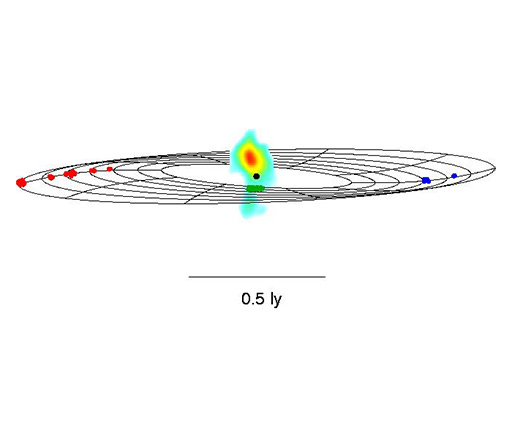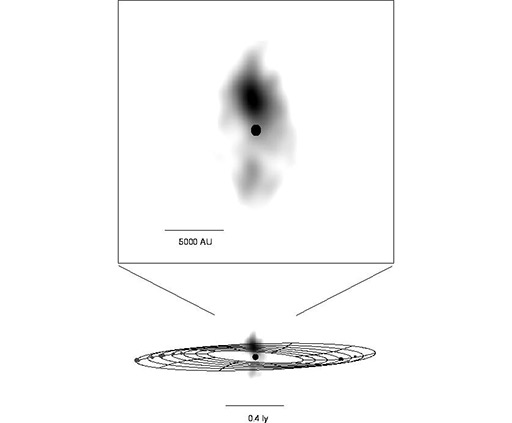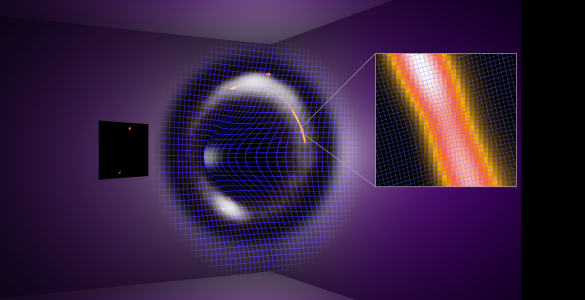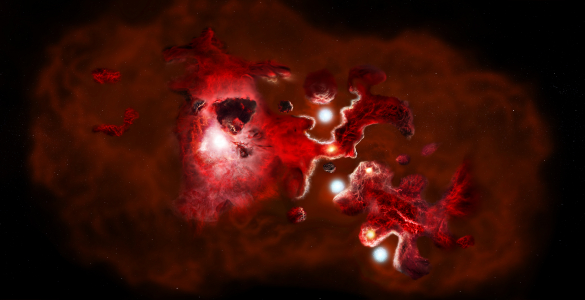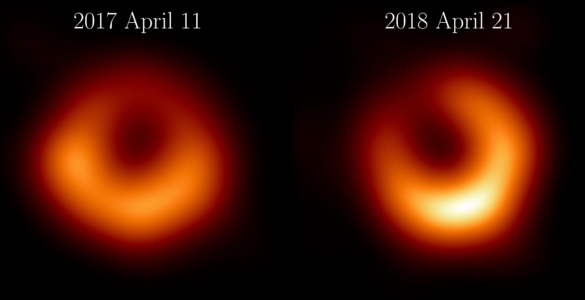An extraordinary cosmic laboratory 21 million light-years away is providing radio astronomers their best opportunity yet to decipher the mysteries of the ultra-powerful “engines” at the hearts of many galaxies and quasars. An international research team using the National Science Foundation’s Very Long Baseline Array (VLBA) and Very Large Array (VLA) radio telescopes has peered deeply into the core of the galaxy NGC 4258, learning important new information about the mysterious region from which high-speed jets of subatomic particles are ejected. The scientists announced their findings today at the American Astronomical Society meeting in Toronto, Ontario.
The new research provides significant quantitative support for a theoretical model for the origin of such jets first proposed in 1979.
NGC 4258 is the galaxy in which a warped disk of water molecules was discovered in 1994. That disk, observed in detail with the VLBA, was shown to be orbiting a central mass some 35 million times more massive than the Sun. That central mass, the astronomers believe, is a black hole. More recent studies of the disk and its surroundings have given astronomers their most detailed look yet at the heart of an active galactic nucleus (AGN), including the ability to pinpoint the exact center of the system, where the black hole resides.
The 1994 observations provided the best evidence to date for the existence of a black hole at the heart of a galaxy. Black holes, so dense that not even light can escape their gravitational fields, have long been suspected as the driving force behind the energetic central engines of AGNs. The fortuitous existence of the molecular disk in NGC 4258 has helped astronomers use the ultrasharp radio “vision” of the continent-wide VLBA to probe with unprecedented clarity into the heart of that galaxy’s central engine.
The researchers are: James Herrnstein, James Moran, and Lincoln Greenhill of the Harvard-Smithsonian Center for Astrophysics; Philip Diamond of the National Radio Astronomy Observatory in Socorro, NM; Mikoto Miyoshi of Japan’s Misusawa Astrogeodynamics Observatory; and Naomasa Nakai and Makoto Inoue of Japan’s Nobeyama Radio Observatory. The work formed the basis of Herrnstein’s Ph.D. dissertation at Harvard University.
The extraordinary detail of the observations is made possible by the fact that the water molecules in the disk orbiting the black hole are amplifying microwave radio emissions in the same manner that a laser amplifies light. These natural amplifiers are called cosmic masers, and they produce bright targets for radio telescopes. Study of water masers at the center of NGC 4258 is what revealed the orbiting disk in 1994.
Further studies of the water masers in NGC 4258 now have allowed the research team to deduce the exact location of the object orbited by the disk. In addition, new observations of the galaxy’s center show radio emission the astronomers believe traces the inner parts of the high-speed jets. Combined, these new observations allow measurement of the distance between the black hole and the innermost observable portions of the jets.
Such measurement is extremely important, because the standard theoretical model, proposed in 1979 by Roger Blandford of Caltech and Arieh Konigl of the University of Chicago, makes a clear prediction that all detected radio emission will be offset from the central engine generating the jets. The new radio observations of NGC 4258 are the first to show the exact location of the core of an AGN, and thus the first to allow measurement of the offset between the core and the detected emission closest to it.
Significantly, the offset measured in NGC 4258 is fully consistent with the quantitative prediction made by the model of Blandford and Konigl.
“There has been a lot of speculation about the relationship between radio jets and black holes over the years,” said Herrnstein. “But this measurement precisely pins down the geometric relationship between them in this object.”
In addition to these measurements, the research team also has recorded the movement of individual maser regions within the orbiting disk. Such motion was expected, and helps further confirm the fact that the masers are indeed part of a disk orbiting a black hole. These motions are seen in masers within the part of the disk closest to our line of sight, where orbital motion would be most evident to us. The masers observed at the edges of the disk (as seen from Earth) do not show any such measurable proper motion over time.
Moran notes that “Although the period of rotation of the megamaser disk is about 800 years, the movement of the masers during the two years of observations was about 60 microarcseconds, equivalent to a motion of about one millimeter seen at a distance of 3,000 kilometers. Being able to witness the disk turning at such a great distance is very exciting.”
Another benefit will come from combining the measurements of the proper motions with measurements of the Doppler shift in the radio emission from the masers at the disk’s edge. These two pieces of information allow the astronomers to calculate the distance to NGC 4258 with greater precision than before. This distance calculation will not be subject to many of the uncertainties that plague other extragalactic distance measurements, and thus will help calibrate the still-uncertain cosmic distance scale for other galaxies.
The researchers still are refining their calculations of the distance, but expect to arrive at a figure accurate within 5 percent.
“Such precision is possible because of the well-understood dynamics of the system,” said Greenhill. “It is a purely trigonometric method, independent of the normal hierarchy of extragalactic distance indicators.”
The galaxy NGC 4258 also is known as Messier 106, and is visible in moderate-sized amateur telescopes in the nighttime winter sky of the northern hemisphere, near the Big Dipper.
The National Radio Astronomy Observatory is a facility of the National Science Foundation, operated under cooperative agreement by Associated Universities, Inc. The Harvard-Smithsonian Center for Astrophysics is operated by the Harvard College Observatory and the Smithsonian Astrophysical Observatory.






